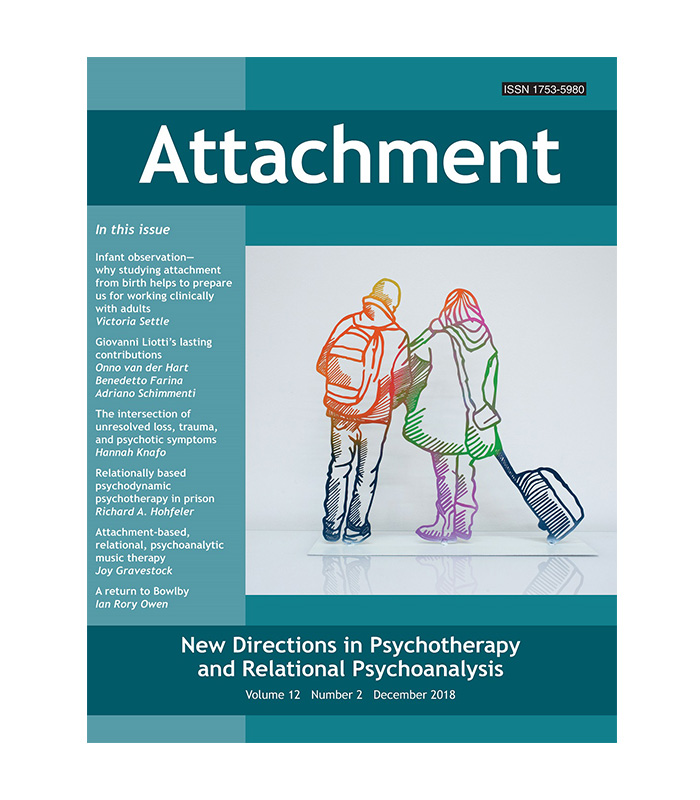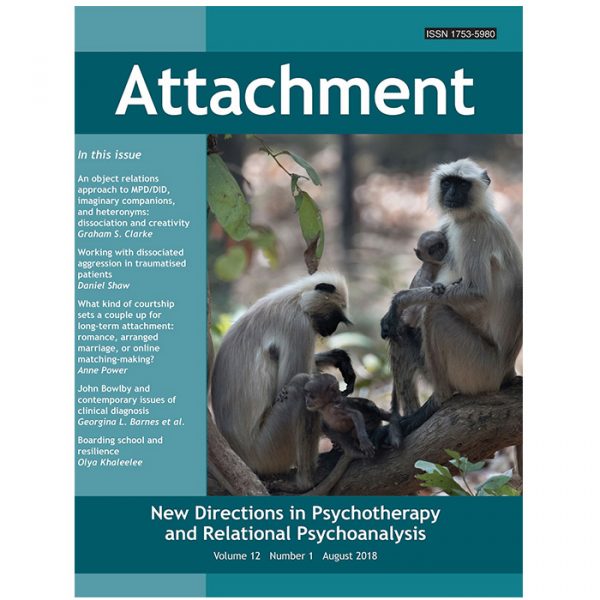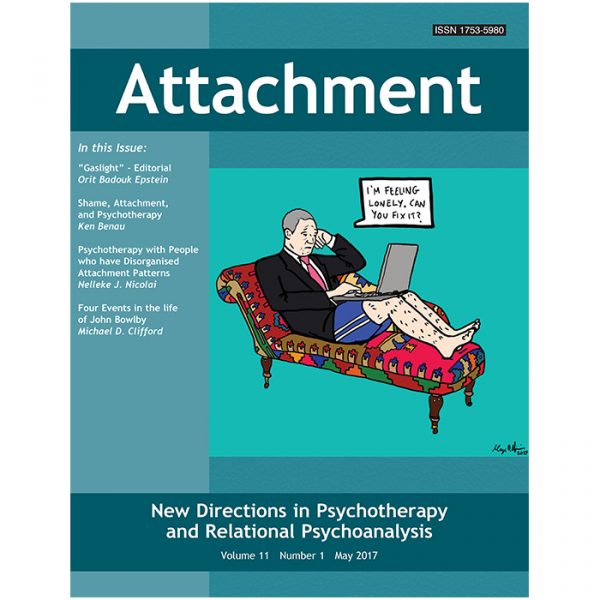ATTACHMENT: New Directions in Psychotherapy and Relational Psychoanalysis
Dr. Aysha Begum: Editor-in-chief
ATTACHMENT is a professional clinical journal for psychologists, psychoanalysts, psychotherapists and clinicians published by The Bowlby Centre, formerly The Centre for Attachment-based Psychoanalytic Psychotherapy. We welcome contributions that further attachment-based relational psychotherapy and contemporary psychoanalytic psychotherapy from colleagues of all clinical orientations.
We encourage submissions for the three designated sections of the journal:
1. Clinical papers:
Advancing the field of attachment-based relational psychotherapy and contemporary psychoanalytic psychotherapy. These clinical papers are reviewed by the editorial team and should aim to have a clear clinical message supported, where appropriate, by theory and relevant referenced literature.
2. Book and creative literature reviews:
Book review requests should be made to the book reviews editor. The journal team will endeavour to match the book to a reviewer who has expertise in the field. Where this is not possible or achievable in a timely manner, we will consider a suggested named reviewer. This should be someone equally expert in the field and all conflicts of interest must be declared.All other creative literature reviews and shorter pieces should follow the directions for the clinical papers (above).
3. Original and research papers:
Advancing the field of attachment-based psychological therapies from all clinical disciplines. These papers are formally peer-reviewed. A second blind copy must be provided. And the manuscript and submission email should clearly mark ‘for peer review’. See notes below.
PROCEDURE FOR SUBMISSION
Submissions can include clinical articles, reports, reviews, commendations, obituaries and editorials, original and research papers. All contributions should be submitted following the instructions provided below on notes to contributors. Final manuscript submissions are to be made to: editor.attachment@gmail.com. In the subject heading please write the full manuscript title and send from the corresponding author’s email.
We welcome submissions on any topic within psychological therapies with an attachment and psychoanalytic focus, that considers the remit of the journal and that it is inclusive of the academic community at large.
Contributions to Attachment for peer-review must report original data and/or research and will be subject to peer reviewers at the discretion of the editor.
We welcome new or recent books which are relevant to the focus of the journal and which you consider would be useful to review for readers.
Journal policy prohibits an author from submitting the same paper for consideration by another journal and does not allow publication of a paper that has been published in whole or in part by another journal. Exceptions to this policy are at the discretion of the editor-in-chief.
Submissions of clinical papers and original and research papers for peer review should be between 4,000–8,000 words in length. The word count includes title, keywords, references, and abstract, but author names and identifying details in the text should be excluded. Submissions for all other items (i.e. book reviews and creative literature reviews) should be 1,000–3,000 words. The word count includes title and details of the reviewed item (i.e. title and author name(s)).
Papers are accepted for consideration on condition that you will agree as author to transfer publication rights to the publisher.
All manuscripts should be supplied in Microsoft Word, Times New Roman font size 12, using double spacing.
Language: Contributions should be written in British English throughout.
Abstracts: All clinical and original and research papers must be accompanied by an abstract of up to 200 words in length.
Keywords: All clinical and original and research papers must include up to 5 keywords.
Subheadings: All clinical and original and research papers must include subheadings the last one being ‘Conclusion’.
Footnotes and endnotes: Will be accepted under exceptional circumstances only.
Figures: The inclusion of figures in black and white are accepted. Figures need to be supplied as separate high-resolution PDFs, EPS, TIFFs, or JPEGs with a descriptive file name, e.g. Figure1, Figure2a. Figures must be cited in the text as (Figure 1), (Figure 2), etc. Each figure should include a title caption and full source e.g. Figure 1 The incidence of mental health issues in the UK adult population, World Health Organization, Report on World Mental Health Issues, 2013
References: should be compiled using the publisher’s house style. Full details can be found at https://firingthemind.com/product/attachment/
Confidentiality and consent: Contributors are expected to use all possible means of protecting the anonymity and confidences of those about whom they write, obtaining their consent or providing deep disguise for all identifying material. In general terms, contributors are required to follow the procedure adopted in their own countries which govern the conduct of their work with human or animal subjects. If requiring further advice, authors are invited to discuss these matters with their relevant supervisory body.
Originality: Papers submitted for publication should not have been published elsewhere or be currently submitted to other publications.
Permissions: Authors are themselves responsible for obtaining permission to reproduce copyright material from other sources.
Copy Dates: Whilst the Editor will welcome contributions at any time, authors should note that final copy dates for forthcoming issues will normally be on 1st January and 1st July of each year.
Compulsory elements for submission
Before you send the final version of your article, you must ensure the following are included:
– Article title and full author name(s)
– Abstract (no more than 200 words)
– Keywords (maximum of five)
– References
– Author biography (maximum length of 100 words)
– Author contact details – email and postal address
Proofs
Manuscripts will be copy-edited for journal house style. Authors will receive page proofs for checking. At this point, no substantial changes can be made to the paper. It is essential that proofs are checked and returned within 48 hours.
Disclaimer
The editor-in-chief makes every effort to ensure the accuracy of all the information (the “Content”) contained in its publications. However, any views expressed in this publication are the views of the authors and are not the views of the editor-in-chief. Responsibility for confidential material and consent obtained to use in publications is that of the authors.
In the interests of clarity and style, we reserve the right to sub-edit manuscripts but all changes will be cleared with authors before publication to ensure that meanings have not been changed. We encourage the use of inclusive language and non-pathologising descriptions of psychological distress. The editorial team have the right to edit or request change of any language deemed culturally offensive or misattuned.
CONTACT
- Editorial enquiries should be sent to attachment@gmail.com
- Request for book reviews should be sent to the book reviews editor at gulcanpurser@gmail.com
To contact The Bowlby Centre:
The Bowlby Centre
1 Highbury Crescent, London, N5 1RN Tel: 020 7700 5070
Email: admin@thebowlbycentre.org.uk Website: www.thebowlbycentre.org.uk
The Bowlby Centre is a Registered Charity, No. 1064780/0 and a Company Limited by Guarantee, No. 3272512



